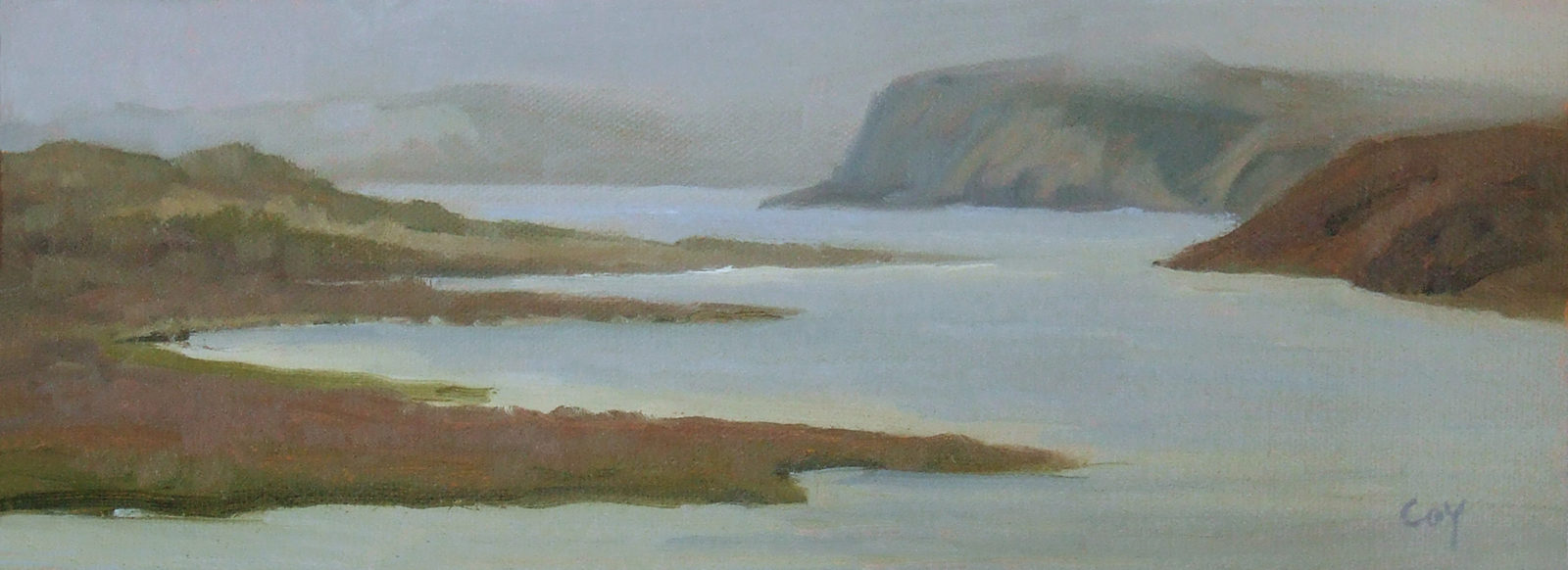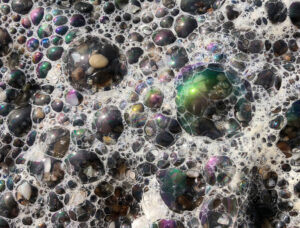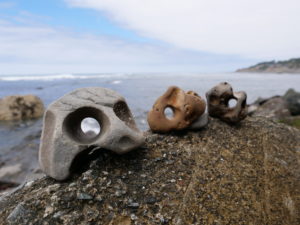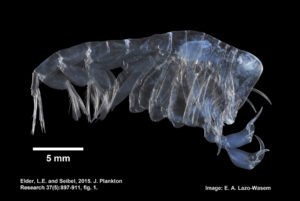The first time I saw Limantour Beach was in 1975, about two days after we’d moved into a little time-share cabin on Silverhills Road outside Point Reyes Station. Tracy–the woman who would become my wife–and I did not know each other very well; the cabin had been a matter of opportunity and impulse. We knew little about the Point Reyes National Seashore either; that first week we took roads mostly at random, knowing that we would eventually fetch up at someplace beautiful.
On Point Reyes, all roads are the right road.
We discovered that there are at least three types of fog at Point Reyes. One is the thick blowy kind, almost the density of whipped cream, that turns everything into a mystery story, one perhaps titled “Where’s That Landmark?” The second kind is a low dense overcast, the meteorological equivalent of a bout of black depression. The third kind hangs low and still over the landscape, drippy and calm and, if you’re dressed for it, infinitely romantic.
As you might have guessed, we encountered Limantour in the third kind of fog. There was hardly anyone on the broad beach because of the gloomy weather; even the gulls were muted. Each end of the sand disappeared into mist; the beach was so featureless we had no idea which direction we were walking. It was very much like our state of mind at the time; very misty and very unsure where we were going. We walked for a long time without reaching anything in particular; then we walked back.
As we were walking back to the parking lot, I saw what at first I thought was a mirage–an all-white deer in the low coastal scrub perhaps 100 feet from where I was standing. It disappeared almost immediately, and I thought perhaps I had conflated the animal out of sundry bushes and trees. At best, I decided, I had seen a brown deer turned white in the fog.
Then I saw it again, more clearly. It was a white deer, as real as the ground under my feet and as metaphorical as a Yeats poem. They’re European deer, brought to parts of this country–Texas and Georgia mostly–as game animals. Their population at Point Reyes grew rapidly, and the park has made numerous and controversial attempts to keep the deer in check through trapping, relocation, contraception, and shooting. But all this was in the future, and I was in a haze of awe. These white deer mostly live in the wilder southern end of the peninsula; I was lucky to see them at Limantour and even luckier to see them my first time there.
White deer on a foggy day on a quiet beach with my new sweetie–it forever linked Limantour and romance in my mind.
Limantour is a spit of land created by longshore drift currents. At the northeast end of the spit is a channel into Drakes Estero, a spectacular spread of water and land, and the more modest Estero de Limantour.
Harbor seals swim just outside the line of breakers on Limantour Beach, and pelicans skim over the water, occasionally taking a headfirst plunge to snare some unwary fish. Sandpipers skitter along the hard sand near the waterline. On the inland side of the spit is a wetlands, popular with egrets, mallards, and (in the winter) wigeon and elegant canvasback ducks. The occasional great blue heron pays a visit. And, need one add, gulls gulls gulls.
One of the unexpected joys of Limantour is that far tip of the spit, where harbor seals bask and cuddle on the sand islands just offshore in the channel. I have watched them for hours; they are occasionally clownish and always magnificent. It has occurred to me occasionally that the seals consider Limantour a prime people-viewing area.
I am not alone in my affection for Limantour; thousands of people make the pilgrimage every year. And yet the beach is so large, and the sand dunes so accommodating to privacy, that you can always feel alone there even on the nicest weekend days. In the winter when the wind is blowing a stiff 30 miles an hour off the point, you can actually be alone, and that ain’t bad either.
Some years ago now Tracy and I lived in Inverness, a tiny town on the Point Reyes Peninsula. It was a golden time filled with good cheer and good company. One of our visitors was Jacques d’Amboise, just retired from his job as a principal dancer with the New York City Ballet. He was looking around for something to do, and we were trying to decide whether I would be a good ghost writer for him.
My two daughters were utterly entranced by Jacques. He was something of a force of nature, a man of great energy and good humor. He was up before we were, preparing breakfast and entertaining the girls.
In the afternoon, we would take a walk somewhere on the point, out to the lighthouse or down by Drakes Estero or, in this case, over the hill to Limantour. It was one of those crystal Bay Area winter days. The Farallones were visible on the horizon; Chimney Rock out by the point seemed as close as my hand. It was toward sunset, and the broad beach was still well populated by strollers and kite fliers.
Jacques suddenly had an idea; he often suddenly had ideas. He wanted to teach our daughters, then 7 and 11, the Wizard of Oz dance. You know the one: Dorothy and the Scarecrow and the Tin Man and the Lion are “off to see the Wizard, the wonderful Wizard of Oz,” and they are dancing down the yellow brick road all happy. (This is before the flying monkeys, but you knew that.)
So he stood between my daughters, took their hands, said “This dance is so easy”–dances were always easy when he did them–and off they went down the sands of Limantour, into the setting sun, skipping and singing and disappearing into the dusk. I just stood and stared. It was a magic moment of unalloyed joy. Eventually I saw them come back the other way, all smiles, still dancing, as the waves kissed their feet and pelicans flew by.
And it all happened at Limantour. It could have happened somewhere else, but it didn’t.
The last time I saw Limantour was two weeks ago. I’m a bit older now, and my enthusiasm for walking up sand dunes has decreased somewhat. I was with my granddaughter, who is now nine. This was the second time she’d been to Limantour, and she enjoyed playing tag with the waves as much as my children had.
Seaweed had washed up on the beach that day, and I found a particularly splendid example, a 12-foot-long whiplike brown clammy rope of bull kelp, with a giant bulb at one end. I began twirling it around, first at knee level and then higher and higher until, with some effort, I had it going over my head. I had to turn my whole body to keep it going, and I got dizzy pretty quickly.
I sat down on the sand to regain my balance. But Tracy had a great idea, and spun the seaweed like gargantuan jump rope, so our granddaughter could jump over it. Almost immediately, I took the other end, and we created a giant ungainly jump rope. Tracy, seeking firmer footing, went down to the water’s edge, thus leading the squealing grandchild into the shallow water. She jumped and jumped; Tracy and I turned and turned. While one part of me was hefting the giant seaweed, another part was standing at a distance, watching the whole thing, delighted to be part of the experience; happy to be alive, happy to be home, happy to enjoy yet another day at my favorite beach.
And it all happened at Limantour. It could have happened somewhere else, but it didn’t.





